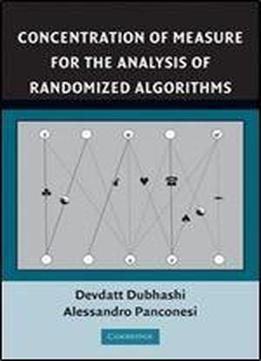
Concentration Of Measure For The Analysis Of Randomized Algorithms
by Devdatt P. Dubhashi /
2009 / English / PDF
2.5 MB Download
Randomized algorithms have become a central part of the algorithms curriculum based on their increasingly widespread use in modern applications. This book presents a coherent and unified treatment of probabilistic techniques for obtaining high- probability estimates on the performance of randomized algorithms. It covers the basic tool kit from the Chernoff-Hoeffding (CH) bounds to more sophisticated techniques like Martingales and isoperimetric inequalities, as well as some recent developments like Talagrand's inequality, transportation cost inequalities, and log-Sobolev inequalities. Along the way, variations on the basic theme are examined, such as CH bounds in dependent settings. The authors emphasize comparative study of the different methods, highlighting respective strengths and weaknesses in concrete example applications. The exposition is tailored to discrete settings sufficient for the analysis of algorithms, avoiding unnecessary measure-theoretic details, thus making the book accessible to computer scientists as well as probabilists and discrete mathematiciansRandomized algorithms have become a central part of the algorithms curriculum based on their increasingly widespread use in modern applications. This book presents a coherent and unified treatment of probabilistic techniques for obtaining high- probability estimates on the performance of randomized algorithms. It covers the basic tool kit from the Chernoff-Hoeffding (CH) bounds to more sophisticated techniques like Martingales and isoperimetric inequalities, as well as some recent developments like Talagrand's inequality, transportation cost inequalities, and log-Sobolev inequalities. Along the way, variations on the basic theme are examined, such as CH bounds in dependent settings. The authors emphasize comparative study of the different methods, highlighting respective strengths and weaknesses in concrete example applications. The exposition is tailored to discrete settings sufficient for the analysis of algorithms, avoiding unnecessary measure-theoretic details, thus making the book accessible to computer scientists as well as probabilists and discrete mathematicians.











